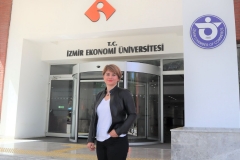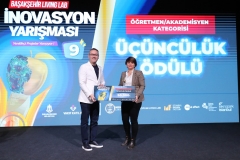
FACULTY OF ENGINEERING
Department of Electrical and Electronics Engineering
EEE 321 | Course Introduction and Application Information
| Course Name |
Electromagnetic Waves
|
|
Code
|
Semester
|
Theory
(hour/week) |
Application/Lab
(hour/week) |
Local Credits
|
ECTS
|
|
EEE 321
|
Fall/Spring
|
2
|
2
|
3
|
6
|
| Prerequisites |
|
|||||||||
| Course Language |
English
|
|||||||||
| Course Type |
Service Course
|
|||||||||
| Course Level |
First Cycle
|
|||||||||
| Mode of Delivery | - | |||||||||
| Teaching Methods and Techniques of the Course | - | |||||||||
| Course Coordinator | - | |||||||||
| Course Lecturer(s) | - | |||||||||
| Assistant(s) | - | |||||||||
| Course Objectives | The main objective of this course is to introduce the fundamental concepts of electromagnetic waves with strong emphasis on engineering electromagnetics. The course begins with an introduction of electromagnetic phenomena in modern applications, including wireless and optical communications, circuits, computer interconnects and peripherals, microwave communications and radar, antennas, sensors, microelectromechanical systems, and power generation and transmission. Fundamentals include quasi static and dynamic solutions to Maxwell’s equations; Uniform plane waves. Plane waves in lossless and lossy media. Skin effect. Flow of electromagnetic power. Poynting’s theorem. Reflection and refraction of waves at planar boundaries. Snell’s law and total internal reflection. Reflection and refraction from lossy media. Guided waves. Parallel Plate and dielectric slab waveguides. Hollow waveguides, cavity resonators, microstrip waveguides, optical fibers. Interaction of fields with matter and particles. Antennas and radiation. |
| Learning Outcomes |
The students who succeeded in this course;
|
| Course Description | Explores electromagnetic phenomena in modern applications, including wireless and optical communications, circuits, computer interconnects and peripherals, microwave communications and radar, antennas, sensors, microelectromechanical systems, and power generation and transmission. Fundamentals include quasi—static and dynamic solutions to Maxwell’s equations; Uniform plane waves. Plane waves in lossless and lossy media. Skin effect. Flow of electromagnetic power. Poynting’s theorem. Reflection and refraction of waves at planar boundaries. Snell’s law and total internal reflection. Reflection and refraction from lossy media. Guided waves. Parallel—plate and dielectric—slab waveguides. Hollow waveguides, cavity resonators, microstrip waveguides, optical fibers. Interaction of fields with matter and particles. Antennas and radiation. |
|
|
Core Courses |
X
|
| Major Area Courses | ||
| Supportive Courses | ||
| Media and Management Skills Courses | ||
| Transferable Skill Courses |
WEEKLY SUBJECTS AND RELATED PREPARATION STUDIES
| Week | Subjects | Related Preparation |
| 1 | Time—Harmonic Fields. Complex Permittivity. Wave Equations. Plane Wave Propagation in Lossless Media. Uniform Plane Waves. General Relation Between E and H. | Chapter 7. Sections 7.1, 7.2 • Fundamentals of Applied Electromagnetics, 6/E, Ulaby, Michielssen & Ravaioli ©2010, Prentice Hall, Published: 02/25/2010, ISBN10: 0132139316 | ISBN13: 9780132139311 |
| 2 | Wave Polarization. Linear Polarization. Circular Polarization. Elliptical Polarization. Liquid Crystal Display (LCD) | Chapter 7. Sections 7.3• Fundamentals of Applied Electromagnetics, 6/E, Ulaby, Michielssen & Ravaioli ©2010, Prentice Hall, Published: 02/25/2010, ISBN10: 0132139316 | ISBN13: 9780132139311 |
| 3 | Plane Wave Propagation in Lossy Media. Low Loss Dielectric. Good Conductor. Current Flow in a Good Conductor | Chapter 7. Sections 7.4, 7.5.• Fundamentals of Applied Electromagnetics, 6/E, Ulaby, Michielssen & Ravaioli ©2010, Prentice Hall, Published: 02/25/2010, ISBN10: 0132139316 | ISBN13: 9780132139311 |
| 4 | Electromagnetic Power Density. Plane Wave in a Lossless Medium. Plane Wave in a Lossy Medium. Decibel Scale for Power Ratios | Chapter 3. Sections 7.6.3• Fundamentals of Applied Electromagnetics, 6/E, Ulaby, Michielssen & Ravaioli ©2010, Prentice Hall, Published: 02/25/2010, ISBN10: 0132139316 | ISBN13: 9780132139311 |
| 5 | Wave Reflection and Transmission at Normal Incidence. Boundary between Lossless Media. TransmissionLine Analogue | Chapter 8. Sections 8.1, 8.1.2• Fundamentals of Applied Electromagnetics, 6/E, Ulaby, Michielssen & Ravaioli ©2010, Prentice Hall, Published: 02/25/2010, ISBN10: 0132139316 | ISBN13: 9780132139311 |
| 6 | Power Flow in Lossless Media. Boundary between Lossy Media. Snell’s Laws. Fiber—Optics, Lasers | Chapter 8. Sections 8.1, 8.3. • Fundamentals of Applied Electromagnetics, 6/E, Ulaby, Michielssen & Ravaioli ©2010, Prentice Hall, Published: 02/25/2010, ISBN10: 0132139316 | ISBN13: 9780132139311 |
| 7 | Wave Reflection and Transmission at Oblique Incidence. Perpendicular Polarization. Parallel Polarization. Brewster Angle. Reflectivity and Transmissivity | Chapter 8. Sections 8.4, 8.5 • Fundamentals of Applied Electromagnetics, 6/E, Ulaby, Michielssen & Ravaioli ©2010, Prentice Hall, Published: 02/25/2010, ISBN10: 0132139316 | ISBN13: 9780132139311 |
| 8 | Waveguides. General Relations for E and H. TM Modes in Rectangular Waveguide. TE Modes in Rectangular Waveguide | Chapter 4. Sections 4.7, 10 • Fundamentals of Applied Electromagnetics, 6/E, Ulaby, Michielssen & Ravaioli ©2010, Prentice Hall, Published: 02/25/2010, ISBN10: 0132139316 | ISBN13: 9780132139311 |
| 9 | Propagation Velocities. Cavity Resonators. Resonant Frequency. Quality Factor | Chapter 8. Sections 8.6, 8.9• Fundamentals of Applied Electromagnetics, 6/E, Ulaby, Michielssen & Ravaioli ©2010, Prentice Hall, Published: 02/25/2010, ISBN10: 0132139316 | ISBN13: 9780132139311 |
| 10 | The Hertzian Dipole. Far Field Approximation. Power Density | Chapter 9. Sections 9.1, 9.1.2.• Fundamentals of Applied Electromagnetics, 6/E, Ulaby, Michielssen & Ravaioli ©2010, Prentice Hall, Published: 02/25/2010, ISBN10: 0132139316 | ISBN13: 9780132139311 |
| 11 | Antenna Radiation Characteristics. Antenna Pattern. Beam Dimensions. Antenna Directivity. Antenna Gain. Radiation Resistance | Chapter 5. Sections 9.2, 9.2.5• Fundamentals of Applied Electromagnetics, 6/E, Ulaby, Michielssen & Ravaioli ©2010, Prentice Hall, Published: 02/25/2010, ISBN10: 0132139316 | ISBN13: 9780132139311 |
| 12 | Half Wave Dipole Antenna. Directivity of λ/2 Dipole. Radiation Resistance of λ/2 Dipole. Quarter Wave Monopole Antenna. Dipole of Arbitrary Length. Health Risks of EM Fields | Chapter 5. Sections 9.3., 9.4 • Fundamentals of Applied Electromagnetics, 6/E, Ulaby, Michielssen & Ravaioli ©2010, Prentice Hall, Published: 02/25/2010, ISBN10: 0132139316 | ISBN13: 9780132139311 |
| 13 | Effective Area of a Receiving Antenna. Friis Transmission Formula. Radiation by Large Aperture Antennas. Rectangular Aperture with Uniform Aperture Distribution. Beamwidth. Directivity and Effective Area | Chapter 9. Sections 9.5 – 9.8.2• Fundamentals of Applied Electromagnetics, 6/E, Ulaby, Michielssen & Ravaioli ©2010, Prentice Hall, Published: 02/25/2010, ISBN10: 0132139316 | ISBN13: 9780132139311 |
| 14 | Antenna Arrays. N Element Array with Uniform Phase Distribution. Electronic Scanning of Arrays. Uniform Amplitude Excitation. Array Feeding | Chapter 9. Sections 9. 9.11 • Fundamentals of Applied Electromagnetics, 6/E, Ulaby, Michielssen & Ravaioli ©2010, Prentice Hall, Published: 02/25/2010, ISBN10: 0132139316 | ISBN13: 9780132139311 |
| 15 | Satellite Communications | Chapter 10. Sections 10.1. , 10.5 • Fundamentals of Applied Electromagnetics, 6/E, Ulaby, Michielssen & Ravaioli ©2010, Prentice Hall, Published: 02/25/2010, ISBN10: 0132139316 | ISBN13: 9780132139311 |
| 16 | Radar Systems | Chapter 10 Sections 6.9 6 .11.2 • Fundamentals of Applied Electromagnetics, 6/E, Ulaby, Michielssen & Ravaioli ©2010, Prentice Hall, Published: 02/25/2010, ISBN10: 0132139316 | ISBN13: 9780132139311 |
| Course Notes/Textbooks | Fundamentals of Applied Electromagnetics, 6/E, Ulaby, Michielssen & Ravaioli ©2010, Prentice Hall, Published: 02/25/2010, ISBN10: 0132139316 | ISBN13: 9780132139311 |
| Suggested Readings/Materials |
EVALUATION SYSTEM
| Semester Activities | Number | Weigthing |
| Participation | ||
| Laboratory / Application | ||
| Field Work | ||
| Quizzes / Studio Critiques |
2
|
20
|
| Portfolio | ||
| Homework / Assignments |
8
|
10
|
| Presentation / Jury | ||
| Project | ||
| Seminar / Workshop | ||
| Oral Exams | ||
| Midterm |
1
|
25
|
| Final Exam |
1
|
35
|
| Total |
| Weighting of Semester Activities on the Final Grade |
65
|
|
| Weighting of End-of-Semester Activities on the Final Grade |
35
|
|
| Total |
ECTS / WORKLOAD TABLE
| Semester Activities | Number | Duration (Hours) | Workload |
|---|---|---|---|
| Theoretical Course Hours (Including exam week: 16 x total hours) |
16
|
2
|
32
|
| Laboratory / Application Hours (Including exam week: '.16.' x total hours) |
16
|
0
|
|
| Study Hours Out of Class |
16
|
4
|
64
|
| Field Work |
0
|
||
| Quizzes / Studio Critiques |
2
|
2
|
4
|
| Portfolio |
0
|
||
| Homework / Assignments |
8
|
4
|
32
|
| Presentation / Jury |
0
|
||
| Project |
0
|
||
| Seminar / Workshop |
0
|
||
| Oral Exam |
0
|
||
| Midterms |
1
|
3
|
3
|
| Final Exam |
1
|
3
|
3
|
| Total |
138
|
COURSE LEARNING OUTCOMES AND PROGRAM QUALIFICATIONS RELATIONSHIP
|
#
|
Program Competencies/Outcomes |
* Contribution Level
|
||||
|
1
|
2
|
3
|
4
|
5
|
||
| 1 | To have adequate knowledge in Mathematics, Science and Electrical and Electronics Engineering; to be able to use theoretical and applied information in these areas on complex engineering problems. |
X | ||||
| 2 | To be able to identify, define, formulate, and solve complex Electrical and Electronics Engineering problems; to be able to select and apply proper analysis and modeling methods for this purpose. |
X | ||||
| 3 | To be able to design a complex system, process, device or product under realistic constraints and conditions, in such a way as to meet the requirements; to be able to apply modern design methods for this purpose. |
X | ||||
| 4 | To be able to devise, select, and use modern techniques and tools needed for analysis and solution of complex problems in Electrical and Electronics Engineering applications; uses computer and information technologies effectively. |
X | ||||
| 5 | To be able to design and conduct experiments, gather data, analyze and interpret results for investigating complex engineering problems or Electrical and Electronics Engineering research topics. |
X | ||||
| 6 | To be able to work efficiently in Electrical and Electronics Engineering disciplinary and multi-disciplinary teams; to be able to work individually. |
X | ||||
| 7 | To be able to communicate effectively in Turkish, both orally and in writing; to be able to author and comprehend written reports, to be able to prepare design and implementation reports, to present effectively, to be able to give and receive clear and comprehensible instructions. |
|||||
| 8 | To have knowledge about global and social impact of engineering practices on health, environment, and safety; to have knowledge about contemporary issues as they pertain to Electrical and Electronics Engineering; to be aware of the legal ramifications of Electrical and Electronics Engineering solutions. |
|||||
| 9 | To be aware of ethical behavior, professional and ethical responsibility; to have knowledge about standards utilized in engineering applications
|
|||||
| 10 | To have knowledge about industrial practices such as project management, risk management, and change management; to have awareness of entrepreneurship and innovation; to have knowledge about sustainable development. |
X | ||||
| 11 | To be able to collect data in the area of Electrical and Electronics Engineering, and to be able to communicate with colleagues in a foreign language. ("European Language Portfolio Global Scale", Level B1) |
X | ||||
| 12 | To be able to speak a second foreign language at a medium level of fluency efficiently. |
|||||
| 13 | To recognize the need for lifelong learning; to be able to access information, to be able to stay current with developments in science and technology; to be able to relate the knowledge accumulated throughout the human history to Electrical and Electronics Engineering. |
X | ||||
*1 Lowest, 2 Low, 3 Average, 4 High, 5 Highest
NEWS |ALL NEWS

Life-saving projects
Students of Izmir University of Economics (IUE) took action in response to the increase in natural disasters such as earthquakes, floods and

IUE Professor elected as a ‘president’
Prof. Dr. Aydın Akan, Head of the Department of Electrical and Electronics Engineering at Izmir University of Economics (IEU), who was featured

IUE academics among the world's top 2% scientists
4 professors from Izmir University of Economics (IUE) were included in the 'World's Most Influential Scientists List' announced by a special research

One of 132 successful women in Europe
Assoc. Prof. Dr. Pınar Oğuz Ekim, Lecturer at Izmir University of Economics (IUE), was awarded a 75 thousand Euro grant from the

Academic-student partnership brought another award
Assoc. Prof. Dr. Pınar Oğuz Ekim, Faculty Member, Izmir University of Economics (IUE) came second in Turkey in the innovation and technology

Made it among the most influential scientists in the world
Three professors from Izmir University of Economics (IUE) were included in the “World's Most Influential Scientists List”, announced by a special research

Academic-student partnership brought success
Assoc. Prof. Dr. Pınar Oğuz Ekim, faculty member at Izmir University of Economics (IUE), has been shown among the top 5 successful

3 friends are on their way to Italy
Three students of Izmir University of Economics (IUE) achieved great success by being accepted to Polytechnic University of Milan, which is known
